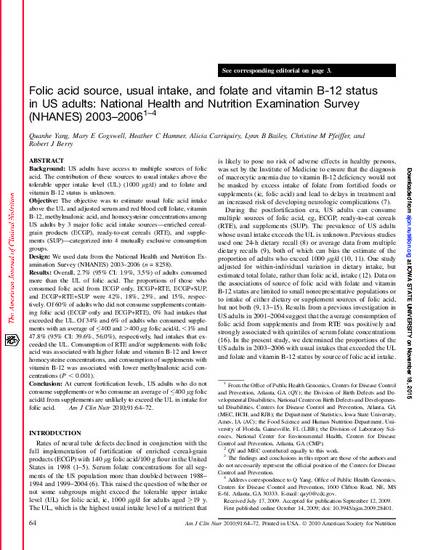
Background: US adults have access to multiple sources of folic acid. The contribution of these sources to usual intakes above the tolerable upper intake level (UL) (1000 ug/d) and to folate and vitamin B-12 status is unknown. Objective: The objective was to estimate usual folic acid intake above the UL and adjusted serum and red blood cell folate, vitamin B-12, methylmalonic acid, and homocysteine concentrations among US adults by 3 major folic acid intake sources - enriched cereal-grain products (ECGP), ready-to-eat cereals (RTE), and supplements (SUP) - categorized into 4 mutually exclusive consumption groups. Design: We used data from the National Health and Nutrition Examination Survey (NHANES) 2003-2006 (n = 8258). Results: Overall, 2.7% (95% CI: 1.9%, 3.5%) of adults consumed more than the UL of folic acid. The proportions of those who consumed folic acid from ECGP only, ECGP+RTE, ECGP+SUP, and ECGP+RTE+SUP were 42%, 18%, 25%, and 15%, respectively. Of 60% of adults who did not consume supplements containing folic acid (ECGP only and ECGP+RTE), 0% had intakes that exceeded the UL. Of 34% and 6% of adults who consumed supplements with an average of <400 and >400 ug folic acid/d, <1% and 47.8% (95% CI: 39.6%, 56.0%), respectively, had intakes that exceeded the UL. Consumption of RTE and/or supplements with folic acid was associated with higher folate and vitamin B-12 and lower homocysteine concentrations, and consumption of supplements with vitamin B-12 was associated with lower methylmalonic acid concentrations (P < 0.001). Conclusion: At current fortification levels, US adults who do not consume supplements or who consume an average of <400 ug folic acid/d from supplements are unlikely to exceed the UL in intake for folic acid.
Available at: http://works.bepress.com/alicia_carriquiry/34/

This article is from American Journal of Clinical Nutrition 91 (2010): 64, doi: 10.3945/ajcn.2009.28401.